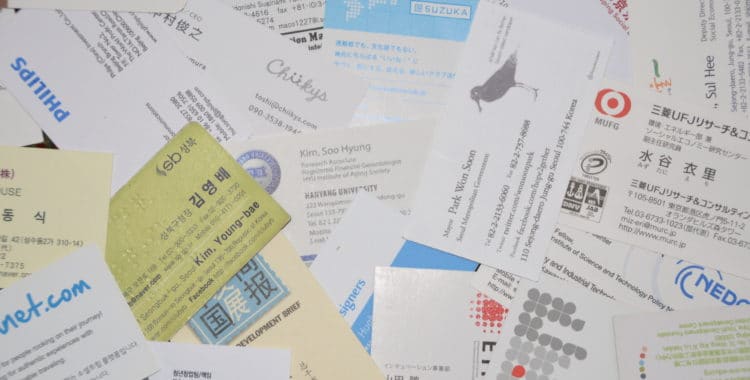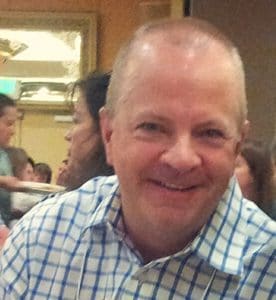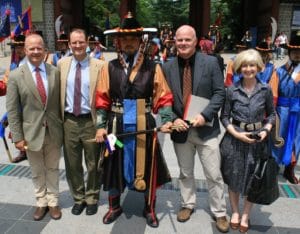


Monday, August 4th, 2014
SVP Boulder County is proud to call the members who make up our ranks “Partners”. Working side-by-side, we’re partners in the vision, and the work that’ll get us there. A dynamic, involved, and invested bunch, this occasional FIELD NOTES series asks Partners to reflect on their lives, involvements, SVP, and what they think matters most.
“SVP Tour of Asia”
By Dan W Catlin, SVP Boulder County Partner
Boulder, Colorado
In the above photo are a few of the many business cards I received on my recent trip to visit three Asian SVPs and their partners in Tokyo, Seoul and Beijing. In all three cities, the formal exchanging of business cards is customary when being introduced, especially in Japan (lots of head bowing and two handed card passing).
I had the chance to travel to three of the world’s largest metropolitan areas as a guest of the local SVP chapters to exchange ideas, learn from each other, and assist some of the newest SVPs and their partners begin their journeys in making an impact in their communities using the SVP model. My traveling companions were Ruth Jones (Executive Director of the SVPI Network Office), Paul Shoemaker (Executive Director SVP Seattle and Founder and first Chair of SVPI) and Fraser Black (SVP Seattle partner and past Seattle Board Chair). We were also joined in Beijing by Mike Caddigan (SVP Seattle partner and Board Member).
Making the places we all live better and caring deeply about doing so, I learned, is a universal concept for SVP partners. I left on my trip mostly oriented as a SVP Boulder partner, and returned feeling deeply connected to the developing global SVP movement. I learned so much about emerging philanthropy in NE Asia, and about my own journey, in the field.

There are some important emerging trends in this region of Asia that have fueled the enthusiasm for the SVP model. A generation of lightning-fast economic growth has created a lot of new wealth. First, extreme wealth, where individuals are realizing they have far more money than they could ever personally need and are asking what to do with it and how to make a difference with the surplus, especially while alive. And second (perhaps more importantly), an increasingly prosperous middle and upper-middle class with extra resources to “invest” in their societies to solve obvious social problems, increase civil efficiencies, provide resources for new community needs.
Like us in the West, their governments can’t or won’t do it all. And, like here at home, people want to become involved in a hands-on, meaningful way that goes beyond more traditional grant making philanthropy; it is a natural environment for the SVP model. All three cities are eager, curious, and anxious to learn and are enthusiastically adopting their own versions of engagements for their partners and communities.
I could write chapters on the nuances between Japan, Korea and China. It’s hard to simplify, but certain themes emerged. I already mentioned the desire to give back, invest in their civil societies and become personally involved in doing so. As we all know, it all starts there. Any successful SVP anywhere begins with a core group of passionate people committed to that. How those early leaders do it always varies from place to place. That’s the beauty of SVP’s ‘local flavor’ model.
In Asia, the needle tends to lean a little more towards the ideas and concepts found in social enterprise to create impact, and what we tend to think of as impact investing versus traditional gift giving philanthropy. These are three societies now firmly rooted in a strong business culture (to varying degrees, and with local characteristics) where traditional donation philanthropy is virtually nonexistent, even without regards to tax law.
 For example, Japan has very similar donation tax treatment to the USA, but the average family only gives away the equivalent of $50-$100 a year – a drop in the bucket, relative to their wealth. In Japan, it was the government and businesses who for decades addressed these issues, but society has awoken to the fact that NGOs must have a role as economies and issues changed (e.g. as with the massive destruction brought by earthquake and tsunami in Japan).
For example, Japan has very similar donation tax treatment to the USA, but the average family only gives away the equivalent of $50-$100 a year – a drop in the bucket, relative to their wealth. In Japan, it was the government and businesses who for decades addressed these issues, but society has awoken to the fact that NGOs must have a role as economies and issues changed (e.g. as with the massive destruction brought by earthquake and tsunami in Japan).
This concept is new for all three societies, and naturally, is influenced by differences in culture, levels of overall economic development, population, geography, and noticeable differences in the type and roles government play (a separate blog post!). What is encouraging and inspiring is how the partners in each city’s SVP are stepping up to be the leaders who solve problems, develop sectors, and promote philanthropic culture.
All three cities have selected their versions of “investees” to do capacity work with, often in the form of slightly more traditional business consulting. Even with variations on partner demographics in the three cities, the focus is clearly on results and increasing impact. Though Japanese health care is free, the hassle factor prevents many from getting the early warning testing and advice to prevent the development of more serious diseases. Partners in Tokyo have made a traditional equity investment, and are consulting with a social enterprise organization that provides cheap blood screenings and health consultations in convenient locations in Japan. The hope is to expand the investee’s business throughout Asia.
 In Korea, the partners are assisting a group promoting the use of truly local tourist guides, offering economic development for each locality, and a better experience and value for the visitor. Established in Korea, this social enterprise is rolling out in Thailand and the Philippines, and eventually expanding across Southeast Asia. It’s run by a young, dynamic female social entrepreneur with the characteristics familiar to us as the traits we seek in our nonprofit leaders at home.
In Korea, the partners are assisting a group promoting the use of truly local tourist guides, offering economic development for each locality, and a better experience and value for the visitor. Established in Korea, this social enterprise is rolling out in Thailand and the Philippines, and eventually expanding across Southeast Asia. It’s run by a young, dynamic female social entrepreneur with the characteristics familiar to us as the traits we seek in our nonprofit leaders at home.
Beijing is just selecting their first investee – a subsidized preschool for the children of migrant workers in the Beijing area. Like here in the USA, there is no free school prior to Kindergarten, so “school readiness” is as big an issue, and many SVPs have plenty of expertise to share with Beijing.
Chinese society has little experience in the culture of group decision making; the nature of authority, big or small, has a different role and connotation there than in the US. Everyone in our traveling party was impressed with the choices the SVPs were making, the eagerness to learn best practices and experiences (often through a translator), and the energy and hands-on work being done as China’s SVPs learn the rules of the road on internal self-organization and self-governance.
Bravo Asian SVPs! You are off to an incredible start.
This trip was life changing for me because what I’m really passionate about as it relates to SVP is creating a culture and environment where people who really care about their communities can get involved in a way that’s personally meaningful and simultaneously make an impact and improve the lives of our fellow citizens. In Asia, where on the surface I have little in common with the people I met (our cultures, backgrounds, histories, experiences, day-to-day lives, material wants/needs, etc. varying widely), I found and felt the desire to make a difference and become personally involved in making change absolutely contagious.
 It energized me, and I found myself wanting to bring that “booster shot” of enthusiasm back to our entire SVP network. I have always felt and believed the SVP exercise was much more than our individual selves (that’s why we join); it extends beyond our local communities and into our country and continent. We are much stronger working together than apart. Now I know this is true of the world as well.
It energized me, and I found myself wanting to bring that “booster shot” of enthusiasm back to our entire SVP network. I have always felt and believed the SVP exercise was much more than our individual selves (that’s why we join); it extends beyond our local communities and into our country and continent. We are much stronger working together than apart. Now I know this is true of the world as well.
Our planet faces many delicate issues, but it is full of people who, despite the obstacles, can and do believe that through their actions, life can be better for all. They are willing and eager to work hard at it. It gives me goose bumps to think about.
I’m one of those people, I hope you are too. More often than not, when experiencing this generous global community, I tell myself my life will never be the same. I am thankful and eternally grateful. I believe in the power of positive change. Everyone can make a difference; everyone has a unique contribution; everyone has a role to play.
This is just the beginning for the global SVP movement. I can’t wait to witness the results. Also, I look forward to more SVP trips in the future…